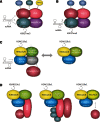Noncoding RNA and Polycomb recruitment
- PMID: 23431328
- PMCID: PMC3677253
- DOI: 10.1261/rna.037598.112
Noncoding RNA and Polycomb recruitment
Abstract
A plethora of noncoding (nc) RNAs has been revealed through the application of high-throughput analysis of the transcriptome, and this has led to an intensive search for possible biological functions attributable to these transcripts. A major category of functional ncRNAs that has emerged is for those that are implicated in coordinate gene silencing, either in cis or in trans. The archetype for this class is the well-studied long ncRNA Xist which functions in cis to bring about transcriptional silencing of an entire X chromosome in female mammals. An important step in X chromosome inactivation is the recruitment of the Polycomb repressive complex PRC2 that mediates histone H3 lysine 27 methylation, a hallmark of the inactive X chromosome, and recent studies have suggested that this occurs as a consequence of PRC2 interacting directly with Xist RNA. Accordingly, other ncRNAs have been linked to PRC2 targeting either in cis or in trans, and here also the mechanism has been proposed to involve direct interaction between PRC2 proteins and the different ncRNAs. In this review, I discuss the evidence for and against this hypothesis, in the process highlighting alternative models and discussing experiments that, in the future, will help to resolve existing discrepancies.
Figures




References
-
- Arrigoni R, Alam SL, Wamstad JA, Bardwell VJ, Sundquist WI, Schreiber-Agus N 2006. The Polycomb-associated protein Rybp is a ubiquitin binding protein. FEBS Lett 580: 6233–6241 - PubMed
-
- Bernstein E, Allis CD 2005. RNA meets chromatin. Genes Dev 19: 1635–1655 - PubMed
-
- Bertone P, Stolc V, Royce TE, Rozowsky JS, Urban AE, Zhu X, Rinn JL, Tongprasit W, Samanta M, Weissman S, et al. 2004. Global identification of human transcribed sequences with genome tiling arrays. Science 306: 2242–2246 - PubMed
-
- Brockdorff N, Ashworth A, Kay GF, McCabe VM, Norris DP, Cooper PJ, Swift S, Rastan S 1992. The product of the mouse Xist gene is a 15 kb inactive X-specific transcript containing no conserved ORF and located in the nucleus. Cell 71: 515–526 - PubMed
Publication types
MeSH terms
Substances
Grants and funding
LinkOut - more resources
Full Text Sources
Other Literature Sources
Molecular Biology Databases
